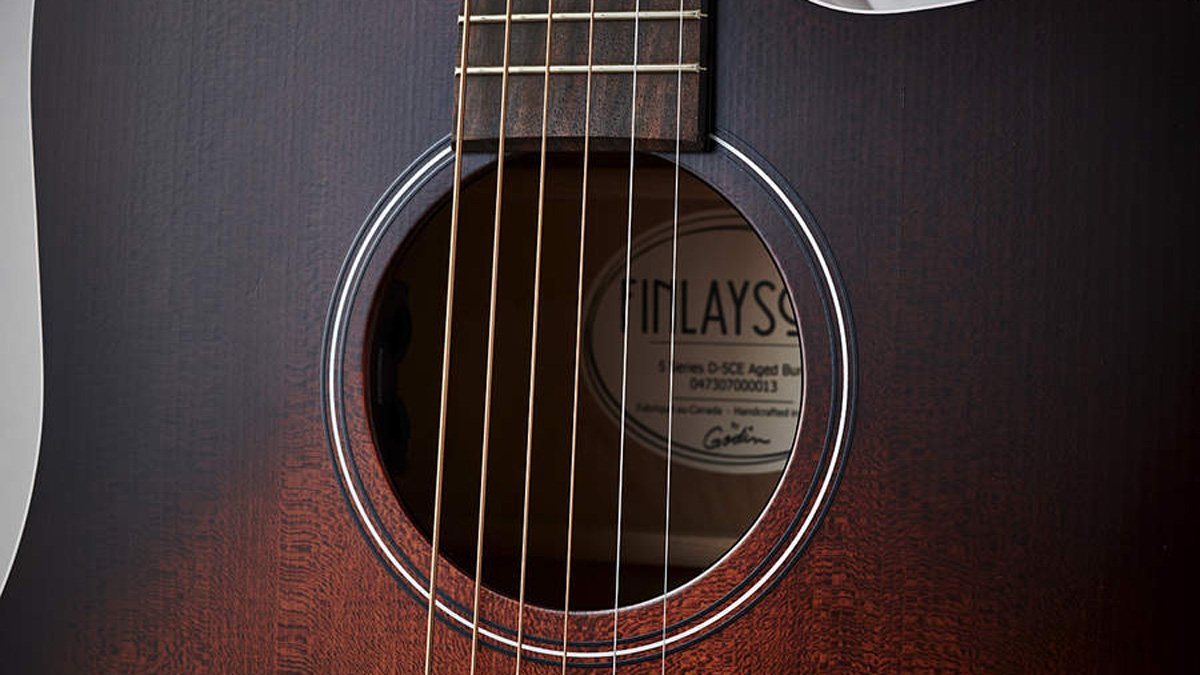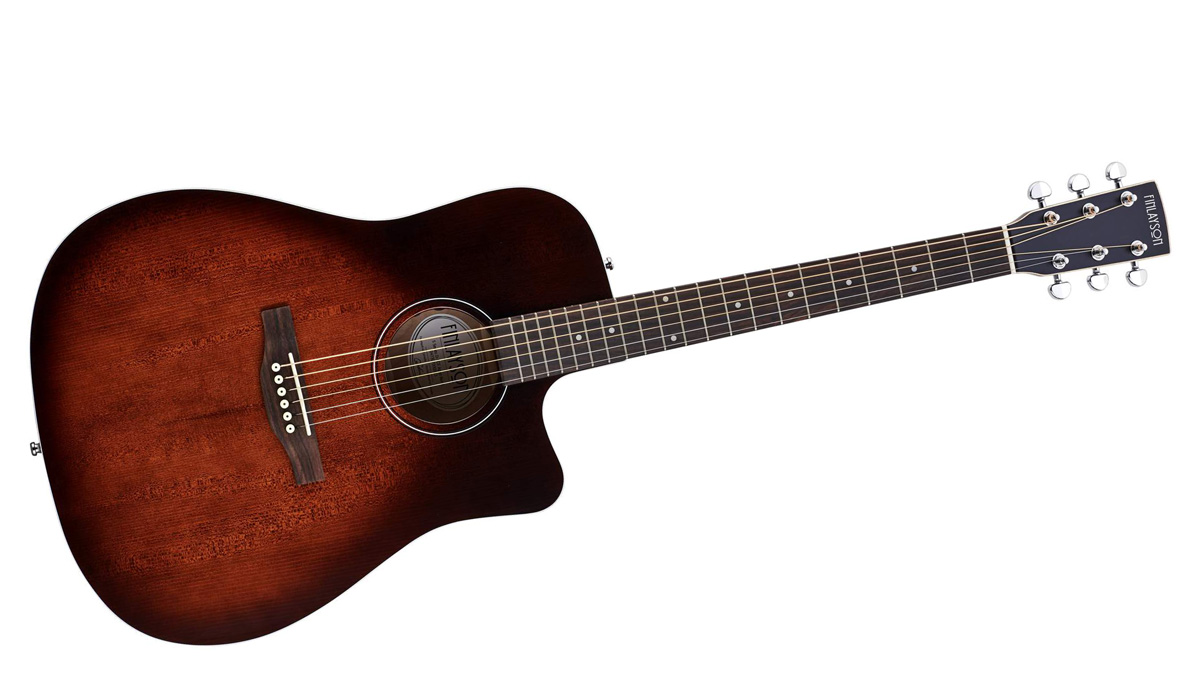MusicRadar Verdict
Killer playability from this newbie.
Pros
- +
Killer playability and build quality should own the mid-range electro market.
- +
Neck profile is boss.
Cons
- -
It doesn’t look all that different from a regular Simon & Patrick, Seagull etc.
MusicRadar's got your back
Nowadays, it’s dead easy to get your name on a range of guitars. Throw some coin at a factory in China; commit to a container load of gear; get your John Hancock silk-screened on the headstocks.
That, in a nutshell, is the biography of many guitar brands you’ll find fattening up the stock online or at your local music store. Of course, we’re not saying there’s owt wrong with that approach. If the punters get what they want, it’s all good. It’s just that we tend to get more excited when we encounter a new guitar range that comes with a juicy backstory.
Here’s the synopsis on newcomer Finlayson. This fledgling brand is a collaboration between respected Scottish luthier Billy Finlayson and prolific Canadian manufacturer Robert Godin, with the results exclusively stocked by UK retailer GuitarGuitar. It turns out that Billy Finlayson had already tried sourcing his guitars from China before manufacturing issues sent him home to think again. The Finlayson reboot came after Billy caught up with Robert Godin in Canada.
“I spent a week with Robert,” remembers Billy. “We toured his factories before chatting into the wee hours about timbers, building techniques, the future of the guitar in general. We speak the same language on most things and share a lot of ideas in regard to how guitars should be built. We made the decision to co-design a new Finlayson range together.”
You recognise Godin as the name behind acoustic brands such as Seagull, Simon & Patrick, Norman, Art & Lutherie, La Patrie, not to mention his eponymous electrics. What he doesn’t normally do is build stuff for anyone else. Aside from the fact the two men hit it off, what brought Godin onboard was Finlayson’s determination to design his guitars from the ground up.
“I spent years developing ideas on the best way to avoid the issues I see on my workbench every week,” says Billy. “Like lifting bridges, the humidity damage that renders guitars unplayable, tuning stability and neck angle distortions. Why weren’t other manufacturers seeing these issues?”
The results of Finlayson and Godin’s brainstorming can be seen, heard and felt in our D-5CE review guitar, although the range actually consists of the entry-level 5 series, the higher-spec 50 models and the top-of-the-line 100 guitars.
The first clue that Finlayson guitars are linked to the home of square sausage, Taggart and comedian Kevin Bridges is the headstock logo. The script is a subtle nod to the work of iconic Glaswegian architect and designer Charles Rennie Mackintosh. It’s a lovely touch, but the real beauty of these guitars lies beneath the surface. For a kickoff, Finlayson guitars are spec’d with tuners that have an 18:1 ratio on low E, A and D strings and an even more precise fine-tuning 26:1 ratio on the treble side. We get Graph Tech TUSQ top nuts and compensated saddles - good enough for many high-end makers. The bridges are glued directly to the bare wood of the soundboard, not the finish, “resulting in great sustain, warmth and responsiveness, while preventing the bridge from lifting later on in life”, according to Billy. Then there’s the soundboard itself. The D-5CE has a solid spruce top.

“There is an optimum strength-to-weight ratio where soundboards are concerned,” explains Billy. “Basically, this means that the soundboard is light enough to function freely but retains enough strength to prevent string tension from distorting it. This strength is determined by the grain of each individual soundboard. At Godin, Finlayson soundboards are cut according to this strength-to-weight ratio. This means every single soundboard is at the optimum thickness and weight to perform at its best.”
Other features that light up the spec sheet include light but strong Adirondack spruce bracing, a dual-action truss rod, and a special neck extension. The latter innovation prevents the infamous hump that manifests at the neck/ body join on traditional acoustic guitars. Caused by changes in humidity, this fault usually means you either have to get the guitar repaired or you hike the action to prevent string buzz. Finlayson’s design protects that area of the fingerboard.
Sounds
The neck profile on the D-5CE is the absolute business. Sculpted from mahogany, this neck is plump without being unmanageable, and there’s a great old-school square shouldered feel that we can’t get enough of.
“Yes, I opted for a more substantial neck profile,” says Billy. “It makes for a more stable neck and requires a lot less adjustment than standard shapes. More importantly, it makes for a stronger coupling to the body, which in turn results in better tonal transference and sustain.”
And certainly tone and sustain are in their abundance. The dreadnought body D-5CE pairs its solid spruce top with laminated red wild cherry back and sides. This classic Godin timber spec combined with a rosewood ’board and the 630mm (24.84-inch) scale length gives the D-5CE more tonal depth and character than we’d imagine from a newly born dreadnought. There’s a softness in the top strings where we’d predict some brashness. The fat strings sustain like a piano.
As the ‘E’ in its model designation suggests, the Fishman Sonitone routes the guitar’s tone through a speaker as well as you’d expect. You also get a volume and tone control hidden just inside the soundhole and adjustable via your fingertips.
Launching your new acoustic guitar brand into a crowded marketplace can leave punters playing a game of six-string Where’s Wally? Finlayson does have the advantage of the support of GuitarGuitar. That, and reviews like ours, should steer you towards trying these excellent guitars for yourself. The feel, playability, tone and build quality are everything you’d expect from a guitar constructed under the watchful eye of Godin. What’s more, Billy Finlayson’s beautifully thought-out innovations enhance your playing experience without distracting you with technology. Everything just works as it should.
Yes, it may be true that everyone can get their name on an acoustic guitar these days. But what you need to do is look beyond the script on the headstock and see whether they put their heart and soul into it, too. Just like Billy.
“I feel like that song had everything we needed to come back with”: Bring Me The Horizon’s Lee Malia on Shadow Moses, its riff and the secrets behind its tone, and why it was the right anthem at the right time
“I said, ‘Are we sure we can write a song about death?’”: The story of Mike + The Mechanics' classic No.1 The Living Years
“Without investment in music education our talent pipeline is at risk of drying up along with the huge opportunities for economic growth it brings”: UK Music draws up five point plan to “turbocharge” music education










